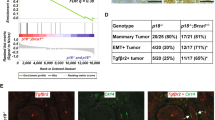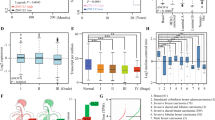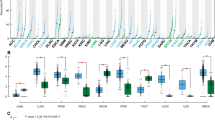Abstract
Expression of the breast cancer-associated gene 1 (BRCA1) in sporadic breast cancers is usually reduced, yet the underlying mechanisms remains elusive. To identify factors that are responsible for reduced BRCA1 expression, we screened 92 known transcription factors for their ability to regulate expression of BRCA1. Among several potential regulators, the Gli-Krueppel-related transcription factor Yin Yang 1 (YY1) showed the most dramatic transactivation of the BRCA1 promoter. YY1 binds to the promoter of BRCA1, and its overexpression resulted in increased expression of BRCA1 and a number of BRCA1 downstream genes. We further showed that overexpression of YY1 in cancer cells inhibited cell proliferation, foci formation and tumor growth in nude mice. To assess the clinical relevance between YY1 and BRCA1, we studied expression of YY1 and BRCA1 from human breast cancer samples and tissue arrays, and detected a significant positive correlation between the level of YY1 and BRCA1 expression in these cancers. Taken together, these findings suggest that YY1 is a key regulator of BRCA1 expression and may be causally linked to the molecular etiology of human breast cancer.
This is a preview of subscription content, access via your institution
Access options
Subscribe to this journal
Receive 50 print issues and online access
$259.00 per year
only $5.18 per issue
Buy this article
- Purchase on Springer Link
- Instant access to full article PDF
Prices may be subject to local taxes which are calculated during checkout






Similar content being viewed by others
References
Affar el B, Gay F, Shi Y, Liu H, Huarte M, Wu S et al. (2006). Essential dosage-dependent functions of the transcription factor yin yang 1 in late embryonic development and cell cycle progression. Mol Cell Biol 26: 3565–3581.
Alberg AJ, Lam AP, Helzlsouer KJ . (1999). Epidemiology, prevention, and early detection of breast cancer. Curr Opin Oncol 11: 435–441.
Atlas E, Stramwasser M, Mueller CR . (2001). A CREB site in the BRCA1 proximal promoter acts as a constitutive transcriptional element. Oncogene 20: 7110–7114.
Atlas E, Stramwasser M, Whiskin K, Mueller CR . (2000). GA-binding protein alpha/beta is a critical regulator of the BRCA1 promoter. Oncogene 19: 1933–1940.
Austen M, Cerni C, Luscher-Firzlaff JM, Luscher B . (1998). YY1 can inhibit c-Myc function through a mechanism requiring DNA binding of YY1 but neither its transactivation domain nor direct interaction with c-Myc. Oncogene 17: 511–520.
Baldassarre G, Battista S, Belletti B, Thakur S, Pentimalli F, Trapasso F et al. (2003). Negative regulation of BRCA1 gene expression by HMGA1 proteins accounts for the reduced BRCA1 protein levels in sporadic breast carcinoma. Mol Cell Biol 23: 2225–2238.
Beger C, Pierce LN, Kruger M, Marcusson EG, Robbins JM, Welcsh P et al. (2001). Identification of Id4 as a regulator of BRCA1 expression by using a ribozyme-library-based inverse genomics approach. Proc Natl Acad Sci USA 98: 130–135.
Birgisdottir V, Stefansson OA, Bodvarsdottir SK, Hilmarsdottir H, Jonasson JG, Eyfjord JE . (2006). Epigenetic silencing and deletion of the BRCA1 gene in sporadic breast cancer. Breast Cancer Res 8: R38.
Brody LC, Biesecker BB . (1998). Breast cancer susceptibility genes. BRCA1 and BRCA2. Medicine (Baltimore) 77: 208–226.
Castellano G, Torrisi E, Ligresti G, Malaponte G, Militello L, Russo AE et al. (2009). The involvement of the transcription factor Yin Yang 1 in cancer development and progression. Cell Cycle 8: 1367–1372.
Deng CX . (2006). BRCA1: cell cycle checkpoint, genetic instability, DNA damage response, and cancer evolution. Nucleic Acids Res 34: 1416–1426.
Drost RM, Jonkers J . (2009). Preclinical mouse models for BRCA1-associated breast cancer. Br J Cancer 101: 1651–1657.
Eccles DM, Pichert G . (2005). Familial non-BRCA1/BRCA2-associated breast cancer. Lancet Oncol 6: 705–711.
Furlong EE, Rein T, Martin F . (1996). YY1 and NF1 both activate the human p53 promoter by alternatively binding to a composite element, and YY1 and E1A cooperate to amplify p53 promoter activity. Mol Cell Biol 16: 5933–5945.
Ghosh S, Lu Y, Hu Y . (2008). A role of CREB in BRCA1 constitutive promoter activity and aromatase basal expression. Int J Biomed Sci 4: 260–265.
Giacinti L, Vici P, Lopez M . (2008). Epigenome: a new target in cancer therapy. Clin Ter 159: 347–360.
Gilbert PM, Mouw JK, Unger MA, Lakins JN, Gbegnon MK, Clemmer VB et al. (2010). HOXA9 regulates BRCA1 expression to modulate human breast tumor phenotype. J Clin Invest 120: 1535–1550.
Glait C, Ravid D, Lee SW, Liscovitch M, Werner H . (2006). Caveolin-1 controls BRCA1 gene expression and cellular localization in human breast cancer cells. FEBS Lett 580: 5268–5274.
Gordon S, Akopyan G, Garban H, Bonavida B . (2006). Transcription factor YY1: structure, function, and therapeutic implications in cancer biology. Oncogene 25: 1125–1142.
Gronroos E, Terentiev AA, Punga T, Ericsson J . (2004). YY1 inhibits the activation of the p53 tumor suppressor in response to genotoxic stress. Proc Natl Acad Sci USA 101: 12165–12170.
Jin Y, Xu XL, Yang MC, Wei F, Ayi TC, Bowcock AM et al. (1997). Cell cycle-dependent colocalization of BARD1 and BRCA1 proteins in discrete nuclear domains. Proc Natl Acad Sci USA 94: 12075–12080.
Kluk BJ, Fu Y, Formolo TA, Zhang L, Hindle AK, Man YG et al. (2010). BP1, an isoform of DLX4 homeoprotein, negatively regulates BRCA1 in sporadic breast cancer. Int J Biol Sci 6: 513–524.
Lee JS, Galvin KM, See RH, Eckner R, Livingston D, Moran E et al. (1995a). Relief of YY1 transcriptional repression by adenovirus E1A is mediated by E1A-associated protein p300. Genes Dev 9: 1188–1198.
Lee JS, See RH, Galvin KM, Wang J, Shi Y . (1995b). Functional interactions between YY1 and adenovirus E1A. Nucleic Acids Res 23: 925–931.
Lee MH, Kim YJ, Yoon WJ, Kim JI, Kim BG, Hwang YS et al. (2005). Dlx5 specifically regulates Runx2 type II expression by binding to homeodomain-response elements in the Runx2 distal promoter. J Biol Chem 280: 35579–35587.
MacDonald G, Stramwasser M, Mueller CR . (2007). Characterization of a negative transcriptional element in the BRCA1 promoter. Breast Cancer Res 9: R49.
Man YG, Fu SW, Schwartz A, Pinzone JJ, Simmens SJ, Berg PE . (2005). Expression of BP1, a novel homeobox gene, correlates with breast cancer progression and invasion. Breast Cancer Res Treat 90: 241–247.
Oliveira AM, Ross JS, Fletcher JA . (2005). Tumor suppressor genes in breast cancer: the gatekeepers and the caretakers. Am J Clin Pathol 124 (Suppl): S16–S28.
Okada S, Ouchi T . (2003). Cell cycle differences in DNA damage-induced BRCA1 phosphorylation affect its subcellular localization. J Biol Chem 278: 2015–2020.
Park K, Atchison ML . (1991). Isolation of a candidate repressor/activator, NF-E1 (YY-1, delta), that binds to the immunoglobulin kappa 3′ enhancer and the immunoglobulin heavy-chain mu E1 site. Proc Natl Acad Sci USA 88: 9804–9808.
Rauch T, Zhong X, Pfeifer GP, Xu X . (2005). 53BP1 is a positive regulator of the BRCA1 promoter. Cell Cycle 4: 1078–1083.
Riggs KJ, Saleque S, Wong KK, Merrell KT, Lee JS, Shi Y et al. (1993). Yin-yang 1 activates the c-myc promoter. Mol Cell Biol 13: 7487–7495.
Rivenbark AG, Coleman WB . (2009). Epigenetic regulation of cystatins in cancer. Front Biosci 14: 453–462.
Ruffner H, Verma IM . (1997). BRCA1 is a cell cycle-regulated nuclear phosphoprotein. Proc Natl Acad Sci USA 94: 7138–7143.
Shi Y, Lee JS, Galvin KM . (1997). Everything you have ever wanted to know about Yin Yang 1. Biochim Biophys Acta 1332: F49–F66.
Shi Y, Seto E, Chang LS, Shenk T . (1991). Transcriptional repression by YY1, a human GLI-Kruppel-related protein, and relief of repression by adenovirus E1A protein. Cell 67: 377–388.
Suen TC, Goss PE . (2001). Identification of a novel transcriptional repressor element located in the first intron of the human BRCA1 gene. Oncogene 20: 440–450.
Sui G, Affar el B, Shi Y, Brignone C, Wall NR, Yin P et al. (2004). Yin Yang 1 is a negative regulator of p53. Cell 117: 859–872.
Tan SH, Baker CC, Stunkel W, Bernard HU . (2003). A transcriptional initiator overlaps with a conserved YY1 binding site in the long control region of human papillomavirus type 16. Virology 305: 486–501.
Thakur S, Croce CM . (1999). Positive regulation of the BRCA1 promoter. J Biol Chem 274: 8837–8843.
Turner JM, Aprelikova O, Xu X, Wang R, Kim S, Chandramouli GV et al. (2004a). BRCA1, histone H2AX phosphorylation, and male meiotic sex chromosome inactivation. Curr Biol 14: 2135–2142.
Turner N, Tutt A, Ashworth A . (2004b). Hallmarks of ‘BRCAness’ in sporadic cancers. Nat Rev Cancer 4: 814–819.
Wang A, Schneider-Broussard R, Kumar AP, MacLeod MC, Johnson DG . (2000). Regulation of BRCA1 expression by the Rb-E2F pathway. J Biol Chem 275: 4532–4536.
Wang CC, Tsai MF, Dai TH, Hong TM, Chan WK, Chen JJ et al. (2007). Synergistic activation of the tumor suppressor, HLJ1, by the transcription factors YY1 and activator protein 1. Cancer Res 67: 4816–4826.
Wang CC, Tsai MF, Hong TM, Chang GC, Chen CY, Yang WM et al. (2005). The transcriptional factor YY1 upregulates the novel invasion suppressor HLJ1 expression and inhibits cancer cell invasion. Oncogene 24: 4081–4093.
Wang RH, Yu H, Deng CX . (2004). A requirement for breast-cancer-associated gene 1 (BRCA1) in the spindle checkpoint. Proc Natl Acad Sci USA 101: 17108–17113.
Wu S, Hu YC, Liu H, Shi Y . (2009). Loss of YY1 impacts the heterochromatic state and meiotic double-strand breaks during mouse spermatogenesis. Mol Cell Biol 29: 6245–6256.
Wu S, Murai S, Kataoka K, Miyagishi M . (2007a). Cooperative regulation of p73 promoter by Yin Yang 1 and E2F1. Nucleic Acids Symp Ser (Oxf) 51: 347–348.
Wu S, Shi Y, Mulligan P, Gay F, Landry J, Liu H et al. (2007b). A YY1-INO80 complex regulates genomic stability through homologous recombination-based repair. Nat Struct Mol Biol 14: 1165–1172.
Wu W, Sato K, Koike A, Nishikawa H, Koizumi H, Venkitaraman AR et al. (2010). HERC2 is an E3 ligase that targets BRCA1 for degradation. Cancer Res 70: 6384–6392.
Xu CF, Brown MA, Nicolai H, Chambers JA, Griffiths BL, Solomon E . (1997a). Isolation and characterisation of the NBR2 gene which lies head to head with the human BRCA1 gene. Hum Mol Genet 6: 1057–1062.
Xu CF, Chambers JA, Solomon E . (1997b). Complex regulation of the BRCA1 gene. J Biol Chem 272: 20994–20997.
Xu X, Aprelikova O, Moens P, Deng CX, Furth PA . (2003). Impaired meiotic DNA-damage repair and lack of crossing-over during spermatogenesis in BRCA1 full-length isoform deficient mice. Development 130: 2001–2012.
Zhang J, Powell SN . (2005). The role of the BRCA1 tumor suppressor in DNA double-strand break repair. Mol Cancer Res 3: 531–539.
Acknowledgements
We thank members of Dr Deng laboratory for their critical discussion of this work and technical assistance. This research was supported by the Intramural Research Program of the National Institute of Diabetes, Digestive and Kidney Diseases, National Institutes of Health, USA.
Author information
Authors and Affiliations
Corresponding author
Ethics declarations
Competing interests
The authors declare no conflict of interest.
Additional information
Supplementary Information accompanies the paper on the Oncogene website
Supplementary information
Rights and permissions
About this article
Cite this article
Lee, MH., Lahusen, T., Wang, RH. et al. Yin Yang 1 positively regulates BRCA1 and inhibits mammary cancer formation. Oncogene 31, 116–127 (2012). https://doi.org/10.1038/onc.2011.217
Received:
Revised:
Accepted:
Published:
Issue Date:
DOI: https://doi.org/10.1038/onc.2011.217
Keywords
This article is cited by
-
BAP1 loss induces mitotic defects in mesothelioma cells through BRCA1-dependent and independent mechanisms
Oncogene (2023)
-
YY1 promotes pancreatic cancer cell proliferation by enhancing mitochondrial respiration
Cancer Cell International (2022)
-
Effect of the transcription factor YY1 on the development of pancreatic endocrine and exocrine tumors: a narrative review
Cell & Bioscience (2021)
-
High expression of eIF4E is associated with tumor macrophage infiltration and leads to poor prognosis in breast cancer
BMC Cancer (2021)
-
YY1-mediated long non-coding RNA Kcnq1ot1 promotes the tumor progression by regulating PTEN via DNMT1 in triple negative breast cancer
Cancer Gene Therapy (2021)



